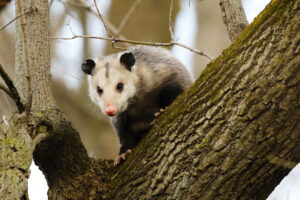Opossums, or “‘possums” as they are casually known, are the only marsupials that live in the United States and Canada, ranging as far south as Costa Rica. Depending on who you ask, they’re cute, cartoonish woodland creatures the size of a plump house cat, or they’re creepy jumbo, rat-looking vermin, complete with naked tails and a nasty habit of raiding garbage cans.
Cute or creepy, there’s no doubt that opossums carry numerous diseases and parasites that can infect you and your pets if you have a close encounter. On the other hand, they are a part of the natural environment with a specific role to play. As long as you give them their space and keep your animals at a distance, there’s no reason you can’t be good neighbors. We’ll summarize the benefits and biohazards of possums, and then give you some tips about how to manage unwanted opossums on your property.
Just the Facts About Opossums
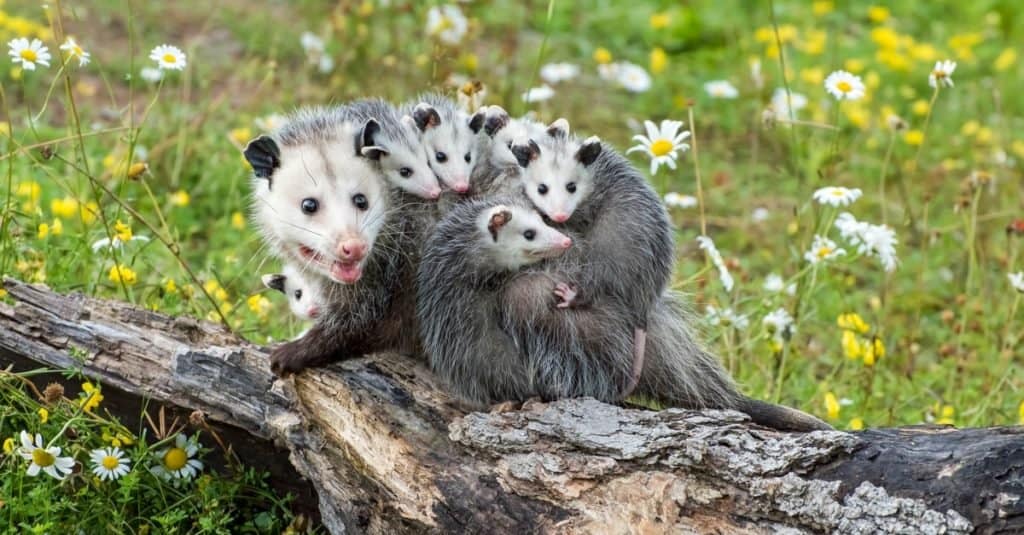
When baby opossums outgrow their mother’s pouch, they begin hitching rides on her back.
©Evelyn D. Harrison/Shutterstock.com
- The correct pronunciation of this animal’s name is “uh-possum,” not “oh-possum.” In the United States and Canada “‘possum” is an acceptable casual name, especially popular in rural areas.
- Opossums are common not only in the countryside but in suburban and urban areas as well.
- They can reach up to 15 pounds, with males growing larger than females.
- As marsupials, opossums carry their young in a pouch. When the babies get larger, they ride on their mother’s back.
- Their feet are similar to those of a raccoon, with long thin fingers that help them climb and pick up food.
- Opossums can use their tails like a fifth hand when climbing to steady themselves, and the young can hang by them. But they don’t have the muscle strength to sleep all night in that position.
- They are slow-moving, so when facing a threat, they temporarily go catatonic. The expression “play ‘possum” comes from this behavior.
- Unfortunately, an opossum’s “play dead” defense doesn’t work on cars. They are one of the most frequently killed animals on the road.
- Opossums carry a variety of diseases that can be transmitted to other mammals, including pets and people. Some of these are transmitted by bites and scratches.
Nuisance Behaviors of Opossums
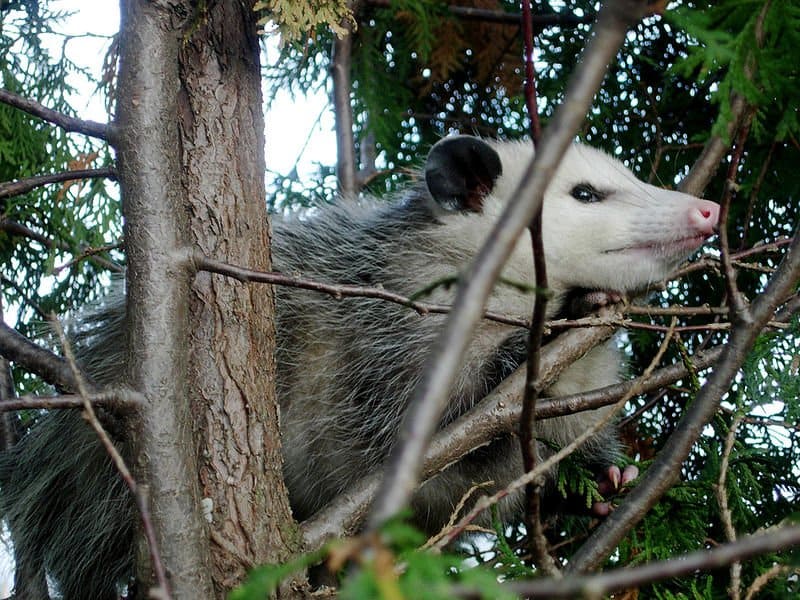
Opossums are excellent climbers, using their tails as a “fifth hand” for balance.
©WolfmanSF – Public Domain
Opossums can create annoyances for homeowners. They are opportunistic omnivores that will eat whatever plants and animals are most conveniently available. Suburban homeowners may find them rummaging through garbage and compost or eating dog or cat food that has been left outdoors. They prefer rotting food, including carrion, but will hunt slugs, insects, and toads. Now and then they will take fruits and vegetables from the garden. They also defecate in yards and on sidewalks and patios.
Opossums also get into vicious fights with domestic dogs and cats and can hurt them and pass disease. They carry fleas, mites, ticks, and lice that pets can pick up from them if they are not taking any preventative medications. Their habit of eating garbage makes them carriers of numerous infectious diseases that can affect people or pets through bites or close contact.
Diseases Opossums May Carry

The sharp teeth of an opossum can act like hypodermic needles to break skin and introduce bacteria.
©iStock.com/rexlis
Opossums can carry all sorts of diseases, but these are some of the most common, in alphabetical order:
1. Chagas Disease
Chagas disease is a parasitic disease that occurs most often in Latin America but sometimes crops up in the southern United States. It can resolve in a short time with symptoms like swelling, fever, rash, fatigue, headache, nausea, diarrhea, and vomiting. If it continues into a chronic phase, it can cause gastrointestinal problems from an enlarged colon and potentially fatal heart problems.
2. Coccidiosis
This is a parasitic intestinal disease spread by feces or ingesting the flesh of an infected animal. Diarrhea is the main symptom. Strains of the disease are to some extent species-specific, but an opossum can carry several different strains. This means you, your dog, and your cat can each get it from an opossum but not from one another.
3. Equine Protozoal Myeloencephalitis (EPM)
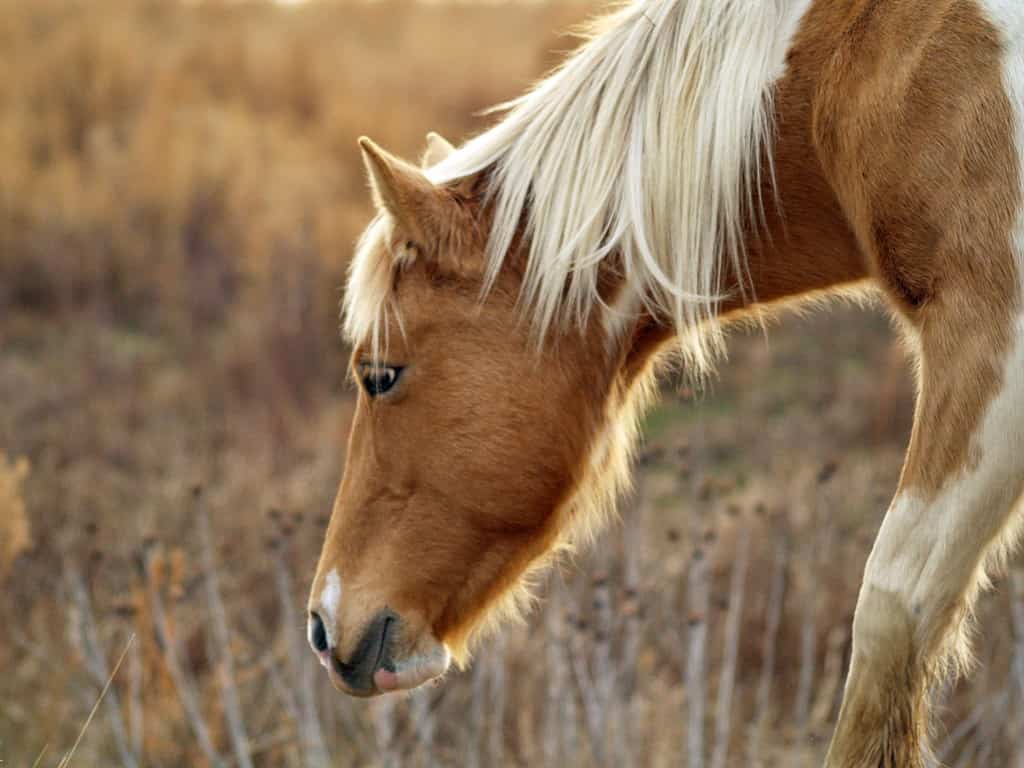
Horses that ingest opossum feces while grazing can catch a serious neurological disease known as EPM.
©Hilary Halliwell / Unsplash – License
As the name indicates, EPM is a neurological disease that infects horses Opossums pick up the disease by eating carrion of infected birds, rodents, or other animals. The microbial parasites that transmit the disease then exit the opossum’s body in feces and infect other animals. Horses that inadvertently consume opossum feces in their food or water can get infected. Some signs your horse may be infected are muscle atrophy, a tilted head, paralysis of one side of the face, beating movements in the eyes, toe dragging, asymmetric stride length, and pelvic sway.
4. Flea-Bourne Typhus
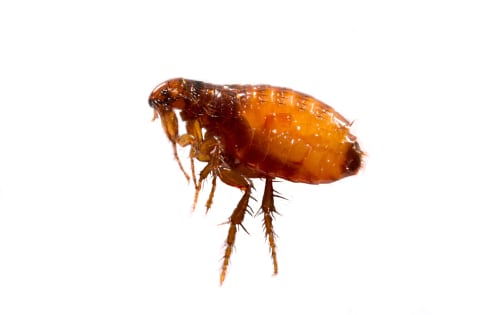
Fleas jump from host to host eating and spreading disease.
©Vera Larina/Shutterstock.com
A bacteria spread by infected fleas is responsible for flea-borne typhus. Animals and people can become infected by flea bites or by breathing in nearly microscopic flea dirt (feces) or rubbing it into their eyes accidentally. The disease is not spread person-to-person. It is a more common disease in tropical climates, so the areas of the United States that are most vulnerable are Hawaii, Southern California, and South Texas. Symptoms of infection can include fever and chills, aches and pains, nausea and vomiting, cough, and sometimes a rash. 99% of people recover from infection with antibiotics, but it is possible for internal organs to be damaged by a serious infection.
5. Leptospirosis

The yellow skin of jaundice can be difficult to spot on an animal, but you can see it in their ears.
©Todorean-Gabriel/Shutterstock.com
This disease comes from a common bacteria found all over the world in water and soil. It is more common in warm, humid climates. It is a zoonotic disease, meaning one that people can catch from animals. Dogs are particularly susceptible. In people, the disease causes flu-like symptoms within days or weeks of infection. It can move on to another more serious stage that can produce meningitis, liver disease, or kidney disease. An infection might produce signs of jaundice, such as yellow skin and eyes.
6. Rabies

Animal bites or scratches are the most common means of spreading rabies and other diseases.
©kckate16/iStock via Getty Images
Rabies is an extremely dangerous viral disease that attacks the central nervous system. People and their pets can catch it if an infected animal bites or scratches them. An infected animal might drool a lot, be uncharacteristically tame or extremely aggressive, bite at imaginary objects, or have trouble moving. A person who might have been exposed to rabies needs to seek treatment immediately. Flu-like symptoms will be the first to appear, followed after a few days by mental confusion, delirium, fear of water, and insomnia. Once these symptoms appear, rabies is 80% fatal for infected people or animals. Rabies in the United States most often occurs in wild animals, including opossums, not pets. However, in foreign countries, rabies is more often spread by stray cats and dogs, so travelers take note!
7. Spotted Fever
Spotted fever rickettsiosis is a term for several diseases, including Rocky Mountain spotted fever. These are all diseases that are caused by tick-transmitted bacteria. Opossums themselves don’t show symptoms of spotted fever, but they carry the ticks that transmit it. If one of these jumps onto you or your pet, they could transmit the disease. Symptoms of infection include fever, headache, muscle pain, and a rash. In the most severe cases, the patient may be left with permanent damage including hearing loss, mental disability, paralysis, and blood vessel damage that can require amputation of digits or limbs.
Managing Opossums on Your Property

Like all wildlife, opossums are fascinating creatures. You don’t have to consider them a nuisance.
©galinast/iStock via Getty Images
Do You Really Want to Get Rid of Them?
Just because you see an opossum on your property doesn’t mean you have to get rid of it. It’s a part of the ecosystem with a function to play. There’s something nice about living in a place that is not totally devoid of wildlife. It can be a little bit of a thrill to receive a notice from your video doorbell and see a possum striding across your sidewalk, minding its business. Possums are only really a problem if you have pets or livestock that spend time outdoors in the evenings and mornings when they are active.
Tips for Keeping Opossums Away:
- Take away their food – Seal garbage cans tightly, don’t leave out dog or cat food, fence your garden and compost pile, and pick up fallen fruit from fruit trees rather than leaving it on the ground.
- Remove shelter – They like to take shelter in wood piles, in thick brush, or under porches. Store your wood inside a shed with closed doors, clean up brush piles, keep shrubbery trimmed, and seal any entry points that may permit an opossum to get under your porch or into a storage shed.
- Set out stinky scents – Opossums hate the smell of ammonia, mothballs, vinegar, onion, peppermint, garlic, and camphor. You can spray these or set them out in coffee cans in parts of the yard opossums might frequent. Just remember, some of these are poisonous to pets!
- Trapping and release – It’s possible to buy an opossum trap to capture the animal alive, but then you have the issue of how to dispose of a live possum. It is not advisable, or legal in some areas, to release an opossum far from where you caught it, as this can spread diseases more quickly. Check with local wildlife agencies for advice.
- Euthanasia – Localities have rules about the humane treatment of animals, ethical ways to euthanize them, and where firearms and other weapons can be used near populated areas. Investigate the laws in your area, even if you are dispatching an animal on your own property.
- Call the Pros – You can’t go wrong calling a professional. They have the know-how and equipment to do the job right, in a way that is humane and within the law.
Taking some preventative steps can keep opossums from getting too close to your house. If they do visit, give them a wide berth and let them do their thing. They’re probably just as curious and wary of you as you are of them.
The photo featured at the top of this post is © Cody Pope / CC BY-SA 2.5, via Wikimedia Commons – License / Original
Thank you for reading! Have some feedback for us? Contact the AZ Animals editorial team.





